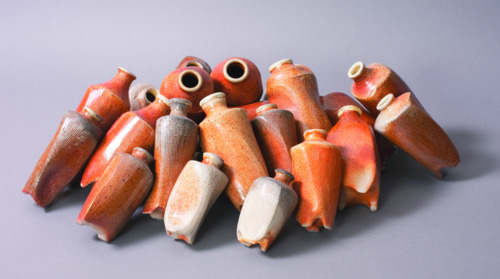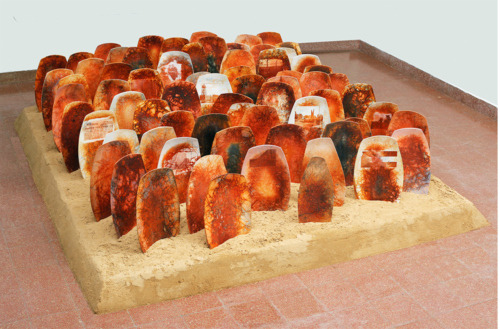
What was the starting point for your investigation with Saggar firing and Terra Sigillata painting?
Terra sigillata painting intrigued my imagination when I was a teenager. At first, I saw Venetian vases decorated with black and white figures and later with color painting, as part of the history and heritage of the eastern Mediterranean board. Years later, when I was already a ceramic artist, I researched terra sigillata and the rediscovery of it in the 20th century, and started to apply it to my work. I tend not to use glazes in my work, except for exterior mural work. Thus, the use of terra sigillata over the last 15 years enabled me to reach a non-shiny and a very appealing color palate, and when fired within saggar vessels in the presence of organic materials or smoked firing, appears to have exciting results. I fire within a saggar, which is an enclosed clay vessel that holds the specific organic material, to get the desired results. Over the years, I have used many forms of organic materials like sawdust, salt Marché, pine needles, various seeds, and fruits. These days, I mainly use pine needles collected from two forests; one in the Carmel mountains and the other one close to my studio.
Tell us more about the process of constructing your works. Does it take much time, do you have to make many preparations?
The manual part of my work: wheel throwing, hand building murals, and sculpting occupy a large part of my time. However, these come after an idea has been formed following considerable thoughts, planning, and designing. Naturally, I am influenced by my roots, the immediate cultural and social environment and by the exposure to anything that touches us as human beings. Therefore, yes, it is a lengthy process.
My preference for the use of sagaar firing also contributes to the prolonged preparatory phase in my work. Bone-dried vessels, made out of white stoneware clay, are covered with three layers of terra sigillata, occasionally decorated with copper cuttings and bisque fired to cone 06. Metal soluble are also used for decoration, and the objects are inserted into clay vessels (saggars) which are just a bit larger than the fired object, and filled up with organic materials, mostly pine needles, pretreated with different oxides. I fire in reduction to around 1000C.
Preparation of murals varies. At times, terra sigilata is applied in different layers on a plasterboard in a reverse pattern, followed by a thin layer of liquid clay. When in a leather-hard state, the board is lifted and cut into tiles, bisque fired and only than saggar fired. In other instances, tiles are painted with terra sigiillata, applied with layers of various copper cutting and even painted with oxides and metal solubles, bisque fired and saggar fired.
In my sculptural work, I use high grog stoneware and treat similarly to my other work with terra sigillata and saggar firing.
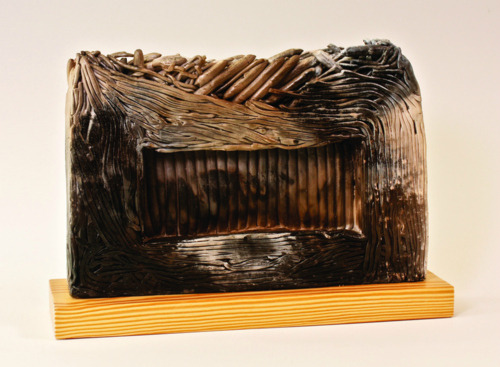
In your career as a ceramic artist, you worked with saggar fired clay, copper and soluble salts, organic materials, etc. You tried many techniques and materials, what did you learn from working with them?
At the beginning of my work with clay I started using terra sigillata in oxidation, over the years I have tried various glazing techniques but always returned to work with terra sigillata and saggar firing. I love the end results and feel connected to its texture and surprising colorfulness. Some of my worked was Raku fired and others in various primitive firing techniques. In addition, about 11 years ago I have started to fire my work in a soda kiln, during the summers when I work at the Harvard University Ceramic program. The results of these soda firings contribute yet another dimension of depth and texture to my work. Overall, I feel that one has to experiment with different techniques, as well as different firing methods. At a certain point, most of us find their preferred method and start to perfect it and adapt it to their own needs. In a way, although much patience is required, we contribute to the evolution of older, sometimes ancient, techniques and apply them in our modern world.
You get your inspiration from the environment and the nature. Can you tell us more about Jaffa, the city you live in, and what motivates you?
My studio is located in Jaffa, which is a city along the eastern Mediterranean shore. It is a very old city with a known history of over 10,000 years. Jaffa’s port is still and has been a functioning port for the last 4000 years. It used to be the main port for pilgrimage to the Holly Land for centuries, an important trade crossroad and even an important site in old-world legends as well as in the Jewish and Christian religions. In Jaffa, one feels the real “East meets West”. It is a multicultural city where Christians, Muslims, and Jews live together, and the shrines, temples and prayer places for all three religions are side by side. The landscape, the culture, and the colors have an immense influence on my work, which can be detected in my murals, sculptural work as well as in other ceramic work. Often, I walk through the city, through its amazing flea markets, the sea shore and streets that display layers upon layers of architecture from Greco-Roman, Byzantine, Arabic, Crusader, Turkish, early 20th century and modern styles.
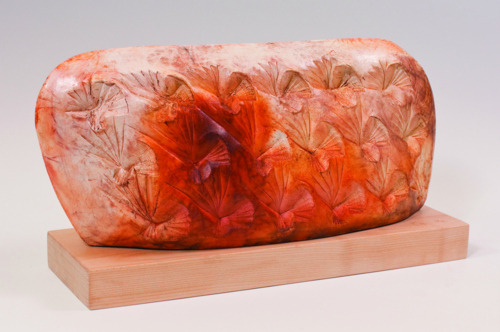
Vivo, 50x35x12 cm. Stoneware, terra sigillata, saggar firing.
For the last decade, you’ve worked every summer at the Harvard Ceramic Studio. Do you remember the first years? Make a comparison and tell us how you evolved there year after year.
My first summer at the Harvard Ceramic program in Boston was about 11 years ago when Ms. Nancy Salvage managed the studio. Nancy was an excellent inspiration for me; she was always full of suggestions concerning what I should do, as well as what I shouldn’t; which master classes I should attend and in general was very much attentive to the newbie I was. Meeting and observing many known ceramic artists in residence and visiting artists, enabled me to widen my horizons at an amazing pace. During the years, there were various symposia including the Islamic symposium. This is where I met Alan Caiger Smith, who thought me his luster technique, and I fired with him twice reduction firing. In 2008, I was invited to the studio as a visiting artists and gave a lecture about my large mural commission by the city of Tel-Aviv, “Voyage through Jaffa”.
Nancy’s retirement, two years ago, passed the management of the studio to Ms. Shawn Penepinto. Last year, I was invited by Shawn to talk about my “China experience” after being invited to participate in the “Tea Pot Biennale “ in Shanghai. Last August I was invited again to give a talk about my two trips to Korea: the Celadon Festival” in Gangjin and the Tea Bowl festival in Muengjeong, South Korea.
The Harvard ceramic studio is my second home. I am very fortunate to be able to investigate, learn, progress and experiment new ideas and venues. Over the years, I have met some wonderful and accomplished artists, like Michelle McClure and Wayne Furst who became colleagues and “fellow fanatics” sharing interest in soda firing.
Bottles, D:8-14 cm, H:12-20 cm. Stoneware, Glaze, Soda firing – View his works
How would you characterize the contemporary ceramic art scene in Israel?
The ceramic scene in Israel is very active. Although this region had a magnificent and long tradition of pottery and ceramics, there hasn’t been continuity between past and modern ceramics as in other places in the world. Israel is a relatively a young and small country with an impressive number of ceramic artists. The Israeli Ceramic Association is very active with about 500 members. We have annual meeting, exhibitions, Biennials, workshop meetings and invited master class artists. We also have one dedicated museum for ceramic art. Lately, we were fortunate to have a new ceramic center, “The Binyamini ceramic Center” which was opened in Tel-Aviv, dedicated to promote ceramic teaching, and hopefully will become a tool for the advancement and development of young artists in Israel.
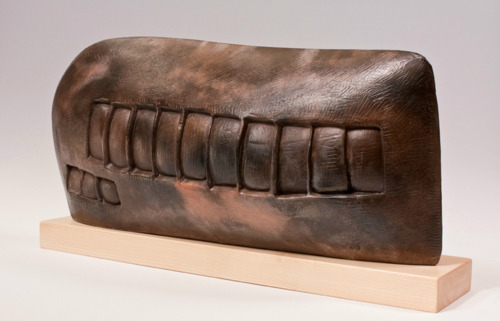
Where can we find you and your works in the next future?
I hope to continue to evolve and continue participating in International exhibition like I have done in the last few years. I tremendously enjoy meeting ceramic artists from other countries and exchange ideas and knowledge. I feel very fortunate and proud that my work is being shown in our cooperative “Altogether 8” in Jerusalem as well as in museums in Israel, China, and South Korea, and being sold in The Israel Museums in Jerusalem and Tel-Aviv, and galleries in London and the US. Recently, I am drawn to sculptural work, which was greatly influenced by my trips to the Far East. I hope to be able to continue in this venue and improve.
It is my conviction that we should all teach others our techniques and knowledge and, therefore, I give a few times a year workshops and do hope to be able to continue to do so in the future.
The owner of a Ceramic Studio in Jaffa, Israel, Shamai Gibsh’s activities include wheel throwing, hand building, and sculpturing.
My ceramic works are focused on esthetic designs. Techniques include Saggar firings of objects covered with terra sigillata and terra sigillata printing, reduction, Raku, and oxidation.
I get inspiration from my environment and surrounding. Jaffa, a 10,000 years old port city a part of Tel-Aviv in Israel – a very old and full of history with its colors and textures, unique architecture and multinational has a big influence on me.
Typically I burnish and cover with terra sigilata, at times I use copper and soluble salts (Metal chlorides like silver, gold, cobalt), and saggar fired inside clay vessels with organic materials typically pine needles.
For the last 11 years, I’ve worked every summer at the Harvard Ceramic Studio. My sculptural work has been inspired by the life in Israel, the political situation in Israel, as well as my recent traveling to China and Korea. There I took a path of a single three dimensional object instead of using multiple objects like in my “wall” Aestela exhibition. Each one of these sculpture represents a wall barrier.
By Vasi Hirdo.
Published in Ceramics Now Magazine Issue 1.
Visit Shamai Gibsh’s website.
View Shamai Gibsh’s profile on Ceramics Now.


